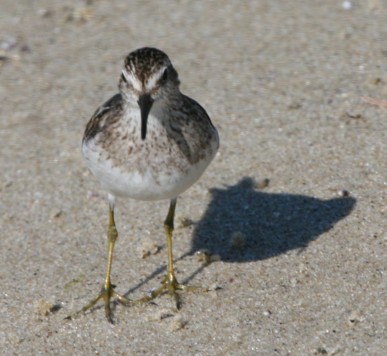Wayne R. Petersen

Well, it’s not the Mona Lisa, but it’s close: it’s a shorebird! And who doesn’t love shorebirds? Hmm…perhaps it’s better not to answer that question. Regardless of one’s taste for shorebirds, the pictured bird represents a stellar example. Faced with this reality, the thoughtful reader should at once focus on the bill of the featured species. It is slim, slightly tapered, and fine tipped—a good start.
Shorebirds can be divided immediately into several major families, two of which are richly represented in Massachusetts—plovers (Charadriidae) and sandpipers and their allies (Scolopacidae). These two families can be easily distinguished by the shapes of their bills. Plovers have short, blunt-tipped bills and some of the larger species have a slight constriction in the middle, e.g., Black-bellied Plover. Many sandpipers have notably finer and proportionately longer bills, and shapes that vary from upturned, e.g., godwits; straight, e.g., Baird’s Sandpiper; or prominently downturned, e.g., Whimbrel. Additionally plovers have large eyes and angular-shaped, rather than rounded heads. Some plovers are prominently banded on their underparts, e.g., Semipalmated Plover, or else they are extensively black in breeding plumage, e.g., Black-bellied and American golden-plovers.
With these points in mind, it is clear the mystery shorebird is a sandpiper. Even in the print journal a look at its legs reveals that they are light in color, and the online rendition shows them to actually be yellowish. This leg color is a key to identifying the mystery species. While Greater and Lesser yellowlegs also have yellow legs, they are much longer-legged and obviously taller than the mystery shorebird. Most of the other yellow-legged possibilities differ in equally distinct ways: by having much longer legs or bills; being more uniform in ventral coloration, e.g., Buff-breasted Sandpiper; or by having a longer, more finely-streaked neck and a thinner, straight bill, e.g., Upland Sandpiper.
Only two regularly occurring shorebirds in Massachusetts exhibit the characteristics of the pictured individual—Least Sandpiper and Pectoral Sandpiper. Pectoral Sandpipers are noticeably larger than Least Sandpipers, and are densely streaked across the breast; their clearly defined breast streaks abruptly end against the white of their belly, not with the ragged interface exhibited by the mystery bird. Also, the bill of a Pectoral Sandpiper is heavier, more notably drooped, and bicolored, with dull yellow at the base, not black as in the pictured bird. The pictured shorebird is an adult Least Sandpiper (Calidris minutilla)—the smallest shorebird species in the world.
A common spring and an abundant fall migrant, Least Sandpipers may be found inland as well as on the coast, where they are especially numerous in July and early August, often preferring muddy flats and salt marshes to the open sandflats preferred by some of the other small sandpiper species. The author photographed this Least Sandpiper on North Beach, Chatham on September 10, 2007.
Wayne R. Petersen